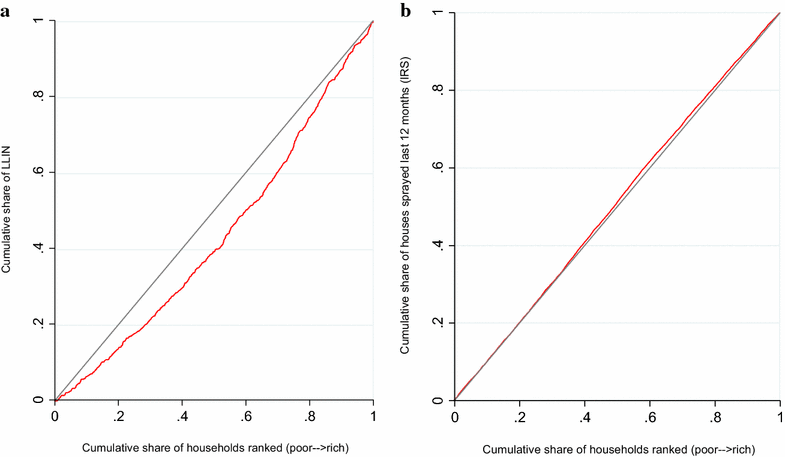Equity in long-lasting insecticidal nets and indoor residual spraying for malaria prevention in a rural South Central Ethiopia
- PMID: 27422024
- PMCID: PMC4947266
- DOI: 10.1186/s12936-016-1425-0
Equity in long-lasting insecticidal nets and indoor residual spraying for malaria prevention in a rural South Central Ethiopia
Abstract
Background: While recognizing the recent achievement in the global fight against malaria, the disease remains a challenge to health systems in low-income countries. Beyond widespread consensuses about prioritizing malaria prevention, little is known about the prevailing status of long-lasting insecticidal nets (LLINs) and indoor residual spraying (IRS) across different levels of wealth strata. The aim of this study was to evaluate the socioeconomic related dimension of inequalities in malaria prevention interventions.
Methods: This study was conducted in July-August 2014 in Adami Tullu district in the South-central Ethiopia, among 6069 households. A cross-sectional data were collected on household characteristics, LLIN ownership and IRS coverage. Principal component analysis technique was used for ranking households based on socioeconomic position. The inequality was measured using concentration indices and concentration curve. Decomposition method was employed in order to quantify the percentage contribution of each socioeconomic related variable on the overall inequality.
Results: The proportion of households with at least one LLIN was 11.6 % and IRS coverage was 72.5 %. The Erreygers normalized concentration index was 0.0627 for LLIN and 0.0383 for IRS. Inequality in LLIN ownership was mainly associated with difference in housing situation, household size and access to mass-media and telecommunication service.
Conclusion: Coverage of LLIN was low and significant more likely to be owned by the rich households, whereas houses were sprayed equitably. The current mass free distribution of LLINs should be followed by periodic refill based on continuous monitoring data.
Keywords: Concentration index; Equity; Ethiopia; IRS; Inequality analysis; LLIN; Malaria prevention.
Figures
Similar articles
-
Factors influencing the ownership and utilization of long-lasting insecticidal nets for malaria prevention in Ethiopia.Malar J. 2017 Jul 1;16(1):262. doi: 10.1186/s12936-017-1907-8. Malar J. 2017. PMID: 28668084 Free PMC article.
-
Impact of combining indoor residual spraying and long-lasting insecticidal nets on Anopheles arabiensis in Ethiopia: results from a cluster randomized controlled trial.Malar J. 2019 May 24;18(1):182. doi: 10.1186/s12936-019-2811-1. Malar J. 2019. PMID: 31126286 Free PMC article. Clinical Trial.
-
Individual and household factors associated with use of insecticide treated nets in southern Ethiopia.Trans R Soc Trop Med Hyg. 2014 Oct;108(10):616-24. doi: 10.1093/trstmh/tru129. Epub 2014 Aug 28. Trans R Soc Trop Med Hyg. 2014. PMID: 25170029
-
Combining indoor residual spraying and insecticide-treated net interventions.Am J Trop Med Hyg. 2009 Sep;81(3):519-24. Am J Trop Med Hyg. 2009. PMID: 19706925 Free PMC article. Review.
-
Feasibility of Malaria Elimination in Ethiopia.Ethiop J Health Sci. 2020 Jul 1;30(4):607-614. doi: 10.4314/ejhs.v30i4.16. Ethiop J Health Sci. 2020. PMID: 33897221 Free PMC article. Review.
Cited by
-
Individual and household factors associated with ownership of long-lasting insecticidal nets and malaria infection in south-central Ethiopia: a case-control study.Malar J. 2017 Oct 6;16(1):402. doi: 10.1186/s12936-017-2048-9. Malar J. 2017. PMID: 28985734 Free PMC article.
-
Barriers of persistent long-lasting insecticidal nets utilization in villages around Lake Tana, Northwest Ethiopia: a qualitative study.BMC Public Health. 2019 Oct 16;19(1):1303. doi: 10.1186/s12889-019-7692-2. BMC Public Health. 2019. PMID: 31619208 Free PMC article.
-
Low use of long-lasting insecticidal nets for malaria prevention in south-central Ethiopia: A community-based cohort study.PLoS One. 2019 Jan 10;14(1):e0210578. doi: 10.1371/journal.pone.0210578. eCollection 2019. PLoS One. 2019. PMID: 30629675 Free PMC article. Clinical Trial.
-
LLIN Evaluation in Uganda Project (LLINEUP2)-Factors associated with coverage and use of long‑lasting insecticidal nets following the 2020-21 national mass distribution campaign: a cross-sectional survey of 12 districts.Malar J. 2022 Oct 19;21(1):293. doi: 10.1186/s12936-022-04302-7. Malar J. 2022. PMID: 36261818 Free PMC article.
-
Cost-effectiveness of a combined intervention of long lasting insecticidal nets and indoor residual spraying compared with each intervention alone for malaria prevention in Ethiopia.Cost Eff Resour Alloc. 2018 Nov 22;16:61. doi: 10.1186/s12962-018-0164-1. eCollection 2018. Cost Eff Resour Alloc. 2018. PMID: 30498400 Free PMC article.
References
-
- World Health Organization . World malaria report 2014. Geneva: World Health Organization; 2014.
-
- MoH . National malaria programme monitoring and evaluation plan 2014–2020. Addis Ababa: Federal Democratic Republic of Ethiopia Ministry of Health; 2014.
-
- WHO . World malaria report 2013. Geneva: World Health Organization; 2013.
-
- WHO . World malaria report 2015. Geneva: World Health Organization; 2015.
Publication types
MeSH terms
LinkOut - more resources
Full Text Sources
Other Literature Sources
Medical


